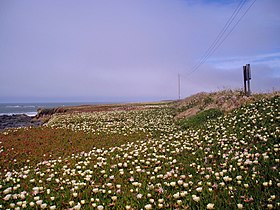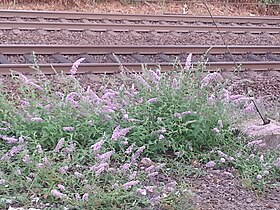Escaped plant
An escaped plant is a
Some
Dispersal
All escaped plants belong to the so-called hemerochoric plants. This term is used across the board for plants that have been introduced directly or indirectly by humans. The term also includes the unintentionally introduced plants that were introduced through seed pollution (speirochoric) or through unintentional transport (agochoric).[6]
Plants may escape from cultivation in various ways, including the dumping of
Occasionally, seed contamination also introduces new plants that could reproduce for a short period of time. The proportion of adventitious species in open ruderal corridors at such locations can exceed 30% of the flora of these locations. Further, ornamental alien plants can easily escape their confined areas (such as gardens and greenhouses) and naturalize if the climate outside changes to their benefit.[12] In the US, there are over 5,000 escaped plants, many of which are escaped ornamentals.[13]
Ecological threats

Many invasive
Neophytes that compete aggressively, and which displace and repel populations of native species, may permanently change the habitat for native species and can become an economic problem. For example, species of Opuntia (prickly pears) have been introduced from America to Australia, and have become wild, thus rendering territories unsuitable for breeding[clarification needed]; the same goes for European gorse (Ulex europaeus) in New Zealand.[15]
Rhododendron species introduced as ornamental garden plants in the British Isles crowd out island vegetation.[16] The same can be seen in many acidic peatlands in the Atlantic and subatlantic climates. Robinia pseudoacacia was imported from America to Central Europe for its rapid growth, and it now threatens the scarce steppe and natural forest areas of the drylands. Examples in forests include Prunus serotina which was initially introduced to speed up the accumulation of humus.
In North America,
Particularly unstable ecosystems, already unbalanced by attacks or possessing certain characteristics, can be further damaged by escaped plants if the vegetation is already weakened. In the humid forests of Australia, escaped plants first colonize along roads and paths and then enter the interior of the regions they surround.[18]
Thunbergia mysorensis, native to India, invaded the rainforests around the coastal city of Cairns in Queensland and even invades trees 40 m high. In Central Australia, the Eurasian species Tamarix aphylla grows along river banks, repelling native tree species, and wildlife that go together, lowers water levels and increases soil salinity. As in the United States, tamarisks have proven to be formidable bio-invaders. The fight against this species of trees, which has spread widely since, appears to be almost hopeless.[19][20]
Related terms
Escaped plants can fall within the definition of, and may have a relation to, these botanical terminologies below:

- Agriophyte: Refers to plant species that have invaded natural or near-natural vegetation and can survive there without human intervention. Established in their new natural habitats, they remain part of natural vegetation even after human influence has ceased, and are independent of humans in their continued existence.Japanese knotweed
- Alien: A non native species introduced by man.[11]: 1123
- Archaeophyte: An alien species introduced by human activity long ago, such as the sweet chestnuts introduced by the Romans in Germany and now part of natural vegetation,[23] and the opium and field poppies.[11]: 93–94
- Epecophyte: Species of recent appearance, usually numerous and constant in the country, but confined to artificial habitats, such as ruderal vegetation. They are dependent on humans for existence that their habitats require constant renewal.[24]
- Ephemerophyte: Species that are only introduced inconsistently, that die briefly from culture or that would disappear again without constant replenishment of seeds. In other words, they can establish themselves temporarily, but they are not in a position to meet all the conditions relating to the territory. A cold winter, or an unusual drought, can lead to the death of these plants; most of the time, they are not able to fight against the local flora in extreme conditions.[25]
- Hemerochory: Plants or their seeds may have been transported voluntarily (introduction) or involuntarily by humans in a territory which they could not have colonized by their own natural mechanisms of dissemination, or at least much more slowly. They are able to maintain themselves in this new vital space without voluntary help from man. Many Central European cultivated and ornamental plants are hemorochoric – insofar as they have escaped and subsist independently of cultivation.[26] These are the forms of hemerochory:
- Agochoric: Plants that are spread through accidental transport with, among other things, ships, trains, and cars. On land, agochoric plants used to be common in harbors, at train stations, or along railway lines. Australia, like New Zealand, has taken stringent measures to prevent the spread by seed or human transport. Agricultural implements imported into Australia must be thoroughly cleaned. Air travelers from other continents are forced to thoroughly clean the soles of their shoes.[27]
- Ethelochoric: Deliberate introduction by seedlings, seeds, or plants in a new habitat by humans. Many cultivated plants which currently play an important role in broad bean and flax, for example.
- Speirochoric: Unintentional introduction by seeds. As all seed samples also contain the seeds of the grasses of the field from which they were obtained, the trade-in seeds of useful plants has also allowed the spread of other species. Speirochoric plants are therefore sown on soil prepared by man and compete with useful plants. corn buttercupare example of plants that were unintentionally scattered.
- Neophyte: An alien species introduced by man after 1500 AD. [11]: 1130
Example species
Examples of escaped plants and/or garden escapees include:
- Alchemilla mollis
- Allium schoenoprasum
- Allium ursinum
- Anredera cordifolia
- Aquilegia vulgaris
- Araujia sericifera
- Ardisia crenata
- Asclepias tuberosa
- Asparagus aethiopicus
- Baccharis halimifolia
- Bartlettina sordida
- Berberis thunbergii
- Borago officinalis
- Bryophyllum delagoense
- Buddleja davidii
- Calystegia silvatica
- Cardiospermum halicacabum
- Carpobrotus edulis
- Castanea sativa
- Cenchrus setaceus
- Centranthus ruber
- Cestrum elegans
- Cestrum parqui
- Clematis orientalis
- Clerodendrum bungei
- Consolida ajacis
- Convallaria majalis
- Coreopsis basalis
- Crocosmia spp.
- Cyclamen persicum
- Cymbalaria muralis
- Delairea odorata
- Dichondra repens
- Digitalis purpurea
- Dolichandra unguis-cati
- Doronicum orientale
- Echinops exaltatus
- Echium candicans
- Elodea canadensis
- Epiphyllum oxypetalum
- Eriocapitella hupehensis
- Erythranthe moschata
- Eschscholzia californica
- Foeniculum vulgare
- Galega officinalis
- Galinsoga parviflora
- Hedera helix
- Hedera hibernica
- Helianthus annuus
- Helianthus tuberosus
- Hemerocallis fulva
- Heracleum mantegazzianum
- Hesperis matronalis
- Ilex aquifolium
- Impatiens glandulifera
- Impatiens parviflora
- Ipomoea cairica
- Ipomoea indica
- Iris pseudacorus
- Isatis tinctoria
- Juglans regia
- Kalanchoe delagoensis
- Kniphofia uvaria
- Laburnum anagyroides
- Lamiastrum galeobdolon
- Lantana camara
- Lavandula stoechas
- Lespedeza bicolor
- Ligustrum lucidum
- Lilium lancifolium
- Linaria purpurea
- Lonicera maackii
- Lysimachia punctata
- Lythrum salicaria
- Macfadyena unguis-cati
- Melastoma sanguineum
- Monarda punctata
- Nothoscordum gracile
- Nymphaea mexicana
- Olea europaea subsp. cuspidata
- Opuntia ficus-indica
- Oxalis debilis
- Papaver cambricum
- Pelargonium peltatum
- Phlox paniculata
- Physalis alkekengi
- Prunus serotina
- Reynoutria japonica
- Rhododendron ponticum
- Ribes rubrum
- Ricinus communis
- Robinia pseudoacacia
- Rubus hawaiensis
- Ruellia simplex
- Senecio angulatus
- Senecio elegans
- Senna pendula
- Silene armeria
- Solanum lycopersicum
- Sparaxis tricolor
- Stachytarpheta mutabilis
- Sphagneticola trilobata
- Talinum paniculatum
- Thymus praecox
- Tradescantia fluminensis
- Tulipa sylvestris
- Vanilla × tahitensis
- Vinca major
- Vinca minor
- Watsonia meriana
Gallery
-
Iceplant refugees along the California Coast
-
Dyer's woad's escape to disturbed roadsides
-
Red valerianfinding refuge atop old walls
-
Castor beanusually finds refuge on wastelands
-
Tiger lily occurs as a garden escapee in Eastern U.S..
-
Buddleja self-sown along a railroad
-
Oxalis latifolia has escaped gardens through seed dispersal.
-
Mother of millions finding refuge in Dapeng Fortress, Shenzhen
See also
- Volunteer plant
- Adventitious plant
- Archaeophyte
- Assisted colonization
- Hemerochory
- Neophyte
Bibliography
- Angelika Lüttig, Juliane Kasten (2003): Hagebutte & Co: Blüten, Früchte und Ausbreitung europäischer Pflanzen. Fauna, Nottuln. ISBN 3-93-598090-6.
- Christian Stolz (2013): Archäologische Zeigerpflanzen: Fallbeispiele aus dem Taunus und dem nördlichen Schleswig-Holstein. Plants as indicators for archaeological find sites: Case studies from the Taunus Mts. and from the northern part of Schleswig-Holstein (Germany). Schriften des Arbeitskreises Landes- und Volkskunde 11.
- Herrando-Moraira, S., Nualart, N., Herrando-Moraira, A. et al. Climatic niche characteristics of native and invasive Lilium lancifolium. Sci Rep 9, 14334 (2019). Climatic niche characteristics of native and invasive Lilium lancifolium
References
- ^ Lantana (Lantana camara) by Weed Management Guide
- ^ Definition of escaped plant Archived 23 August 2021 at the Wayback Machine by Dave's Garden
- ^ Mulvaney M (2001) The effect of introduction pressure on the naturalisation of ornamental woody plants in south-eastern Australia. In 'Weed Risk Assessment'. (Eds RH Groves, FD Panetta, JG Virtue). (CSIRO Publishing: Collingwood)
- ^ garden escape by treeterms.co.uk. Philip Wilson in association with Orange Pippin & Warren IT Services. Retrieved 30 December 2023.
- ^ Escaped Ornamentals by Washington State Noxious Weed Control Board. Retrieved 1 January 2024.
- ^ Loss and degradation of native plant and animal habitat by invasion of escaped garden plants, including aquatic plants – Introduction Department of Agriculture, Water and the Environment
- Science Daily, 22 March 2016
- ^ Escaping Ornamentals: A Threat to Natural Area Biodiversity By Miriam Owsley, Outreach Assistant, Northwest Michigan Invasive Species Network. 23 November 2016.
- ^ UTRICULARIA CONTAINMENT: TRYING TOPREVENT THE GREAT ESCAPE THOMAS M. CAHILL. Department of Integrated Natural Sciences. Arizona State University at the West Campus. Retrieved 16 December 2023.
- ^ Wilhelm Lohmeyer, Herbert Sukopp: Agriophytes in the vegetation of Central Europe. First addendum. 2001 (Braunschweiger Geobotanische Arbeit 8), pp. 179–220
- ^ ISBN 978-1-5272-2630-2.
- ^ Starfinger U, Kowarik I, Rode M, Schepker H. 2003. From desirable ornamental plant to pest to accepted addition to the flora? The perception of an alien plant species, Prunus serotina, through the centuries. Biol. Invas. 5:323–335
- ^ Escaped Ornamentals Escaped Ornamentals: Is your garden harboring environmental pollutants? Washington State Noxious Weed Control Board
- NSW Government
- ^ Australia's weedy garden escapees by The Invasive Species Council
- PMID 15016441.
- ^ Kowarik I (2005) Urban ornamentals escaped from cultivation. In: Gressel J (ed) Crop Ferality and Volunteerism. CRC Press, Boca Raton, pp. 97–121.
- ^ Rejmanek M, Richardson DM, Higgins, SI, Pitcairn, PJ, Grotkopp E (2005) Ecology of invasive plants: state of the art. In 'Invasive Alien Species. A New Synthesis' (Eds. HA Mooney, RN Mack, JA McNeely, LE Neville, PJ Schei, JK Waage), pp104-161. (Island Press, Washington DC)
- ^ van Klinken, Rieks; Campbell, Shane; Heard, Tim; McKenzie, John; March, Nathan (2009). "The Biology of Australian Weeds: 54. 'Parkinsonia aculeata' L". Plant Protection Quarterly. 24 (3): 100–117.
- ^ Griffin, G.F.; Smith, D.M.S.; Morton, S.R.; Allan, G.E.; Masters, K.A.; Preece, N. (1989). "Status and implications of the invasion of tamarisk (Tamarix aphylla) on the Finke River, Northern Territory, Australia". Journal of Environmental Management. 29 (4): 297–315.
- ^ Handbook of Plant Palaeoecology, Flora and Vegetation, p.95 By R. T. J. Cappers, R. Neef
- ^ Plant Ecology, p.496 By Ernst-Detlef Schulze, Erwin Beck, Klaus Müller-Hohenstein
- ^ Wilhelm Lohmeyer, Herbert Sukopp: Agriophytes in the vegetation of Central Europe. Landwirtschaftsverlag, Münster-Hiltrup 1992, ISBN 3-7843-2073-2
- ^ Potentials and Limitations of Ecosystem Analysis, Extinction and Naturalization of Plant Species p.261, edited by Ernst-Detlef Schulze, Helmut Zwölfer
- ^ Ingolf Kühn, Stefan Klotz: Floristic status and alien species. In: Series of publications for vegetation science. 38 (2002), pp. 47–56.
- ^ Harshberger, John William: The vegetation of the New Jersey pine-barrens, an ecologic investigation, Philadelphia: Christopher Sower Company, 1869–1929
- ^ Tim Low: Feral Future. The Untold Story of Australia's Exotic Invaders, p. 73








